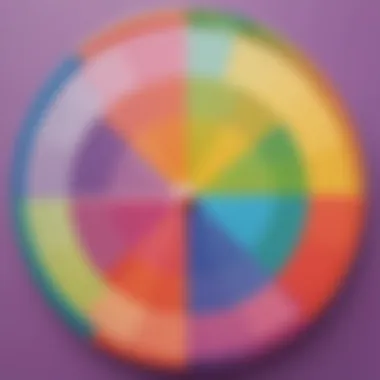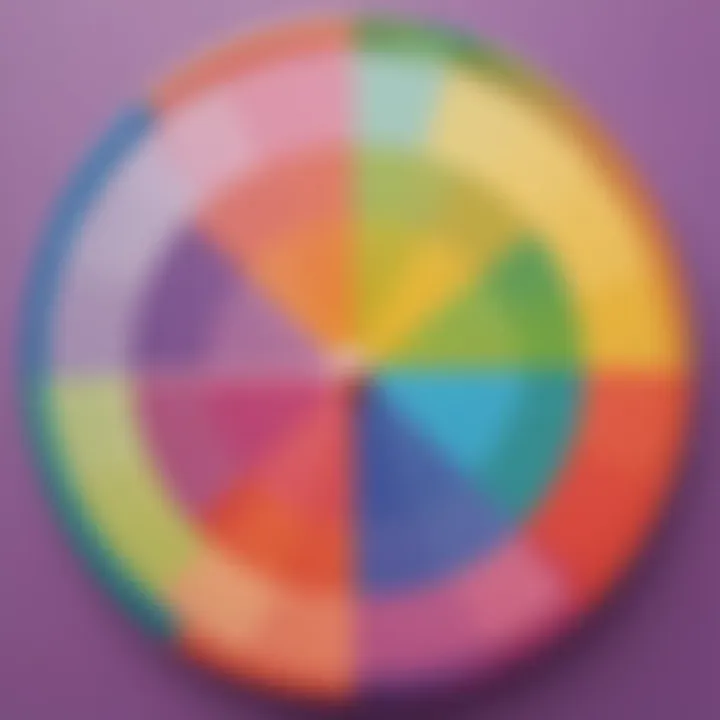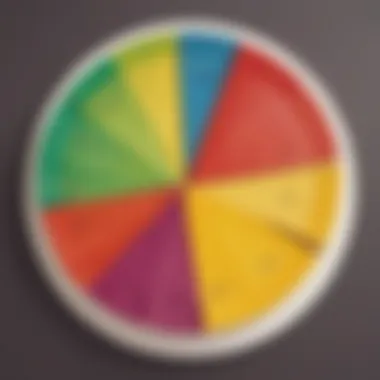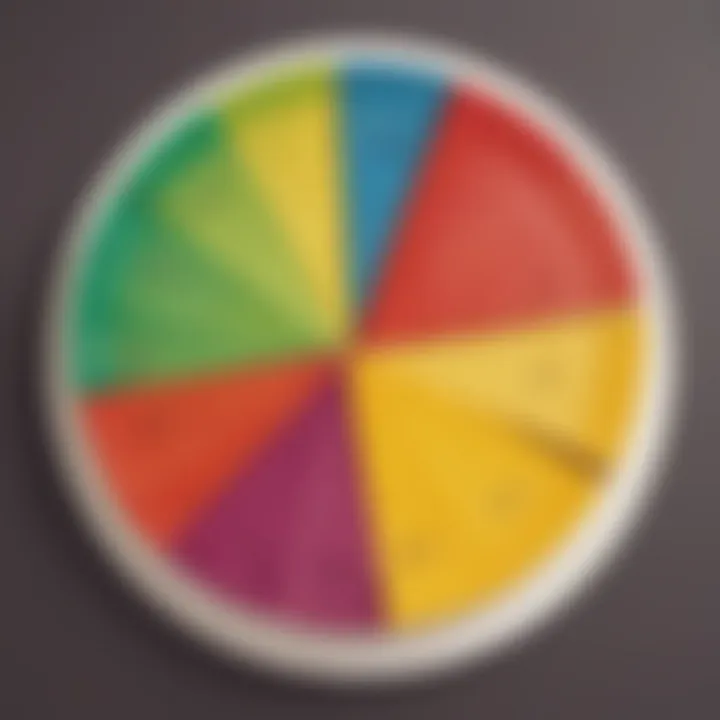Understanding Fractions Step by Step: A Guide for Kids


Intro
Fractions play a crucial role in mathematics. For elementary school children, understanding fractions is essential for grasping larger, more complex concepts later on. This guide explores fractions carefully. We break down the subject in an easy-to-understand manner. As students work through the steps outlined here, they will build a strong foundation that they can use in future studies.
Through this guide, we aim to engage young minds thoroughly while ensuring comprehension of various aspects of fractions. Teachers, parents, and caregivers will discover helpful techniques to make learning fractions enjoyable embracing practical applications and cohesive learning experiences. Along this learning journey, children's growing knowledge of fractions will pave the way for a lifelong relationship with mathematics.
Creative Activities
Creative activities enrich the learning process. Incorporating hands-on experiences obsesses better engagement with the subject matter. For fractions, there exist many craft ideas, which serve both educational value and enjoyment.
Craft Ideas
Children can delve into scratch paper, scissors, and glue to create fraction visuals. One popular craft is the Fraction Pizza. Kids can cut paper into different fractional slices like 1/2, 1/4, and 1/8. This can enhance their ability to visualize and understand how fractions compose a whole.
Step-by-Step Guides
- Material Needed: Gather scrap paper, scissors, and colored markers.
- Cut the Paper: Cut circles out of the paper to draw pizzas.
- Slice the Pizza: Next, slice the paper shapes into fractions.
- Label the Fraction Slices: Write the fraction on each sliced piece.
- Create a Fun Presentation: Discuss with friends how these slices can add up to 1 whole pie.
Educational Value
Engaging in these crafts fosters mathematical sense while catering to visual learners. Projects like the Fraction Pizza allow children to visualize numbers and better understand how they interact. This hands-on approach makes fractions less abstract, allowing methods to become clearer for students.
Fun Quizzes
Incorporating quizzes engages students and reinforces their learning. Several quiz topics focus on fundamental fraction concepts, serving the purpose of evaluating comprehension levels effectively.
Quiz Topics
Using quizzes from online platforms provides a variety of offerings, including: textiles about basic fraction division, addition of fractions and identifying fractions in everyday life scenarios. These help are ideal for testing knowledge alignment with classroom instructions.
Question Types
Quizzes employ various question types such as multiple choice, true or false, and fill-in-the-blank.
These formats challenge students intellectually while enticing them with variety to sustain interest. By practicing regularly, children develop a deeper understanding of fraction concepts emerging naturally with use.
Knowledge Reinforcement
Quizzes play a vital role in consolidating understanding. They encourage learners to reflect on key ideas. As students answer thematic questions, gaps in knowledge may become apparent. This promotes discussion with teachers. Addressing misgivings ensures effective learning.
Fact-Based Articles
Reading supplemental articles holds educational significance as well. Exposure to diverse topics generates curiosity while enthusiastically educating young minds about fractions which thematically connects more challenging future learnings.
Topics
Various fundamental slides enrich children with relatable concepts and applications of fractions. These growing connections broaden the mind's horizon within responsive educational environments.
Engaging Content
Articles succinctly present information ensuring access to elementary-level knowledge. Simple language and visual aids complement text to foster calm and effective understanding for early math learners. Offline resources may also mirror select info.
Prelims to Fractions
Fractions form a crucial part of mathematics. Understanding them is essential swtarting point for young learners. In this article, we explore the concepts of fractions, what they mean and why they are important. With effective learning strategies, children can grasp uses of fractions early, allowing for confidence in future mathemtical studies.
What is a Fraction?
A fraction is a way of showng parts of a whole. It consists of two numbers: the numerator and the denominator. The numerator is the top number; it indicates how many parts we have. The denominator, the bottom number, tells us how many equal parts make up a whole. For example, in the fraction 3/4, the number 3 is the numerator, and 4 is the denominator. This means we have three parts out of a total of four.
Fractions can represent many things, like slices of pizza, intervals of time, or sections of a whole object. Students begin to see how fractions are utilized in daily life. Understanding their structure is necessary for further operations with fractions, like adding or subtracting them.
The Importance of Fractions
Fractions are important for several reasons. First, they build a foundation for various mathematical concepts, such as ratios and proportions. They help in comprehending more advanced topics later, like algebra and calculus. Besides their academic value, fractions are very relevant in real-life scenarios:
- Cooking: Recipes require precise fraction measurements. For instance, halving a recipe is a practical application of fractions.
- Finance: Understanding fractions assists in grasping percentages and discounts, aiding smart decisions while shopping.
- Time management: Fractions help in dividing time equally, fostering skills in scheduling tasks efficiently.
Ultimately, mastering fractions can enhance problem-solving skills important across many domains, not only in academics but also in everyday tasks.
Basic Terminology
Understanding fractions requires a solid grasp of certain key terms. These terms provide a framework that helps learners articulate complex ideas with greater clarity and confidence. By focusing on basic terminology, educators can enhance the students’ ability to understand more intricate operations and concepts involving fractions.
Numerator and Denominator
A fraction consists of two main parts: the numerator and the denominator. The numerator, located at the top of the fraction, represents the number of parts we have. It is essential in showing how many equal parts of a whole we are considering. Conversely, the denominator, positioned at the bottom, signifies the total number of equal parts that make up the whole.
For instance, in the fraction 3/4, 3 is the numerator and 4 is the denominator. This precisely indicates that among four equal parts, three parts are involved.
Notably, understanding these two components leads to improved comprehension when manipulating fractions in various arithmetic operations. By recognizing their functions, students gain insight into how to make sense of operations such as addition, subtraction, multiplication, or division involving fractions.
Types of Fractions
Fractions can be classified into different types based on their characteristics, primarily proper, improper, and mixed numbers. Here is an overview of each type of fraction and its role within fraction learning.
Proper Fractions
Proper fractions are those where the numerator is less than the denominator. In mathematical terms, this means that the value of the fraction is always less than one. A common example would be 2/5. The key characteristic of proper fractions is their relative simplicity in comparison to larger values. This simplicity aids young learners in building a foundational understanding of fractions while asserting a sense of accomplishment.
A notable advantage of proper fractions is that they effectively illustrate the concept of parts of a whole, making them particularly beneficial for elementary students. They also play a crucial role in more advanced fraction concepts, setting the stage for learning about improper fractions and mixed numbers later on.
Improper Fractions
Improper fractions are characterized by having numerators greater than or equal to the denominator. This signifies that the value of the fraction can be one or greater. For instance, 5/3 qualifies as an improper fraction. Here, the primary characteristic is the ratio being greater than one.
Understanding improper fractions is important because they often arise in various real-life situations. They also prepare students for concepts like mixed numbers. However, students sometimes find these fractions challenging, as the implications can seem less clear than those of proper fractions. Overall, recognizing improper fractions is beneficial, as it broadens students’ capacities to handle diverse numerical representations.
Mixed Numbers
Mixed numbers combine a whole number and a proper fraction, delivering a distinct representation of a value greater than one. An example would be 1 ¾. This unique form personas a visual balance between whole values and fraction parts, offering a comprehensible means to express values beyond the simple integer form.


Mixed numbers serve as a beneficial tool as they can aid in understanding context in fractions—many real-life situations use mixed number representations. This parallel flourishes idea consciousness, engaging students to recognize that fractions are not arbitrary, but rather grounding them in practical application.
In summary, comprehending the various types of fractions—proper, improper, and mixed—is essential in developing proficiency in math. Each type contributes distinct advantages and contexts as learners progress in their mathematical instruction.
Visualizing Fractions
Visualizing fractions enables a deeper understanding of how they work. The two primary methods discussed here are pie charts and number lines. Each method serves to make abstract concepts more tangible for elementary students. When learners can see fractions visually, they grasp their significance better than through numerical representation alone. It prepares learners for future topics in math. Additionally, visualization can enhance retention by connecting the material to experiences they might encounter in daily life.
Using Pie Charts
Pie charts provide a circular representation of fractions, showing how different parts create a whole. Each segment of the pie denotes a fraction of the entire circle. Let’s consider an example to solidify the understanding:
- A pie chart representing a pizza.
- If half of the pizza is pepperoni and the other half is cheese, then we can say that the chart shows 1/2 for pepperoni and 1/2 for cheese.
When students look at the pie chart, they can easily comprehend what fractions actually show. It visually represents relationships between parts and a whole. Watching the pie chart can highlight equal sections. This enhances the appreciation of proper and improper fractions.
“Visual representation aids more than memorization.”
Being able to see the denominator and numerator in pie charts helps children connect to fractions in real-life scenarios, like splitting food or sharing something with friends.
Using Number Lines
Number lines offer a clear, linear perspective of fractions. They illustrate where fractions sit among whole numbers. For example, if we take 0, 1/2, and 1, these fractions can be marked directly on a number line.
- Locate 0 and 1.
- Divide the space between them into equal segments. Each segment can illustrate a simple fraction such as 1/4, 1/2, and 3/4.
This method helps students recognize that fractions are not just isolated numbers. They are part of a continuous set stretching between integers. Furthermore, it enables students to better understand larger fractions as they can be represented accurately within the number line completely and not just left as apparent gaps.
Educators can ask students to add or subtract fractions using number lines, helping improve their arithmetic skills. The flexibility of marking and moving along the line with various fractions increases their familiarity with fractions overall.
Using these two methods together can symbolize fraction concepts profoundly while remaining enjoyable for learners. By incorporating pie charts and number lines into lesson plans, teachers support their students' educational growth and underline the relevance of fractions, both in academic and real-life situations.
How to Simplify Fractions
Simplifying fractions is an essential skill in mathematics. It makes fractions easier to understand and work with. When fractions are in their simplest form, they are clearer and more efficient in calculations. Understanding this concept brings many benefits.
Simplifying fractions helps in easier addition, subtraction, multiplication, and division. It also prepares students for more complex mathematical operations down the line. Hence, grasping how to simplify fractions ensures a strong mathematical foundation.
Finding the Greatest Common Factor
The process of simplifying a fraction begins with finding the greatest common factor (GCF) of the numerator and the denominator. The GCF is the largest number that can divide both numbers without leaving a remainder. For example:
- Identify Factors: List down the factors of both the numerator and denominator.
- Find the GCF: Identify the highest factor that appears in both lists.
- If you have the fraction 8/12, the factors of 8 are 1, 2, 4, 8 and for 12, they are 1, 2, 3, 4, 6, 12.
- In this case, the GCF is 4.
Knowing the GCF is vital because it allows us to reduce fractions by dividing the numerator and the denominator by this common factor, making it easier to understand and work with.
Step-by-Step Simplification Process
The simplification process can be broken down into simple steps:
- Identify the original fraction, e.g., 8/12.
- Find the GCF you calculated before, which is 4.
- Divide both the numerator and denominator by the GCF:
- Write the fraction in its simplest form: 2/3.
- 8 ÷ 4 = 2
- 12 ÷ 4 = 3
Below is a summary of the process:
- Take the fraction.
- Calculate the GCF.
- Divide both the numerator and denominator by that GCF.
- Present the fraction as a simplified version.
Simplifying fractions not only helps with calculations but also encourages clear communication of mathematical ideas. It is a vital skill building block for understanding larger numerical concepts.
Mastering the simplification of fractions enables better manipulation of fractions in future calculations. It is a straightforward yet powerful aspect of mathematical literacy.
Adding Fractions
Adding fractions is fundamental in mathematics. Understanding this concept paves the way for more complex operations. When we add fractions accurately, we can solve various real-life problems more efficiently. Hence, mastering this topic will build a strong mathematical foundation for young learners.
Same Denominator
When two fractions have the same denominator, adding them becomes a simple task. The process involves maintaining the common denominator while combining the numerators. For example, when adding
( \frac14 ) and ( \frac34 ), the addition works as follows:
- Retain the denominator (4).
- Add the numerators (1 + 3) to get 4.
- Therefore, ( \frac14 + \frac34 = \frac44 = 1 ).
This method illustrates that combining fractions with the same denominator is straightforward. It ensures learners can quickly grasp addition without feeling overwhelmed. A visual representation can aid understanding. Using pie charts or number lines can help children see how fractions come together. Thorough explanatory practices in this area create confidence and clarity in applying similar logic in further situations.
Different Denominators
Adding fractions with different denominators requires extra attention. In such cases, it is essential first to find a common denominator. This is the smallest number that both denominators can share. Let's take the fractions ( \frac13 ) and ( \frac14 ) as an example. To add these:
- Find the Least Common Denominator (LCD): The smallest multiple of 3 and 4 is 12.
- Convert the Fractions:
- Add the Converted Fractions: Now add the converted numerators: ( \frac412 + \frac312 = \frac712 )
- ( \frac13 = \frac412 )
- ( \frac14 = \frac312 )
Understanding this concept takes time. However, with practice, children will navigate these problems with ease. Illustrating the process through visuals, similar examples, and hands-on exercises can significantly aid comprehension.
The key to mastering fractions lies in consistent practice and application in real-world scenarios. Proper understanding builds confidence in mathematical skills.
Subtracting Fractions
Subtracting fractions is a fundamental part of working with fractions in mathematics. This section highlights why understanding how to subtract fractions is essential for building a strong foundation in fraction concepts. It lays the groundwork for further mathematical applications by providing insight into the mechanics behind subtraction processes.
When we subtract fractions, we often deal with common scenarios that require clarity in understanding. Young learners gain valuable skills as they develop precise problem-solving methods through tasks that involve subtraction. It helps them build confidence and further their appreciation for mathematics itself.
Same Denominator
Subtracting fractions with the same denominator is straightforward. When both fractions share a common denominator, the process only involves subtracting the numerators. This simplicity opens the door for understanding the mechanics behind fractions.
For example, consider the fractions


- 3/8 and 1/8.
To subtract:
- Take the numerators: 3 and 1.
- Subtract 1 from 3, which equals 2.
- Keep the same denominator, which is 8.
- So: 3/8 - 1/8 = 2/8.
- This simplifies to 1/4 when reduced, as both can be divided by 2.
It is important to show young learners that only the numerators change when we have the same denominator, which simplifies learning.
Different Denominators
Subtracting fractions with different denominators requires a more thoughtful approach. In this case, we first need to find a common denominator. After that, we convert the fractions and follow similar steps of subtraction as before.
Let us look at an example using the fractions
- 3/4 and 1/2. To perform the subtraction:
- Determine the least common denominator (LCD), which is 4 in this case.
- Convert the second fraction: 1/2 becomes 2/4 by multiplying the numerator and denominator by 2.
- Now the fractions are 3/4 and 2/4.
- Subtract the numerators: 3 - 2 = 1.
- Keep the common denominator, which remains 4.
- The final answer is 1/4.
Understanding how to find a common denominator teaches effective fraction management, preparing learners for real-life math applications.
With strong comprehension of both the same and different denominators, children are now equipped to manipulate fractions skillfully. Each step taken enhances numerical fluency in a topic foundational for future learning. Understanding these concepts cements their knowledge and supports their ongoing mathematical education.
Multiplying Fractions
Understanding how to multiply fractions is essential in mastering this topic. It helps in developing more advanced mathematical skills, which are necessary for various applications. By learning to multiply fractions, students will find it easier to handle fractions in everyday situations, such as cooking, construction, or budgeting.
Step-by-Step Multiplication
Multiplying fractions involves a straightforward approach. Here is a clear step-by-step process to follow:
- Multiply the Numerators: Start by multiplying the top numbers (numerators) of the fractions together.
- Multiply the Denominators: Next, multiply the bottom numbers (denominators) of the fractions together.
- Keep it Simple: The result will form a new fraction. If possible, simplify that fraction so it’s easier to work with. “Simplifying” means reducing the fraction to its simplest form, implying that you divide the numerator and the denominator by their greatest common factor.
Example
If you want to multiply 1/2 by 3/4:
- Multiply 1 and 3 (the numerators) to get 3.
- Multiply 2 and 4 (the denominators) to get 8.
- The new fraction is 3/8, which is already simplified.
This systematic approach allows for greater accuracy and confidence when multiplying fractions and aids in retention of the material.
Understanding Fraction Multiplication
It's crucial to grasp the concept that multiplying two fractions is not about combining parts, but rather scaling one fraction by another. Think of it this way: you are taking part of a part. This operates on the principle that the distribution of values leads to interesting outcomes.
Multiplying the fractions effectively scales down the total. Following the previous example of 1/2 times 3/4, intuitively, if you have half of a pizza and you want to see what three-quarters of that portion equals, you multiply those fractions. The multiplication exponentiates the action of sharing and partitioning.
- Real-Life Applications: This method appears regularly in numerous daily contexts. When minimizing ingredients in a recipe, for instance, mastery of fractional multiplication leads to precise results.
- Visualization: Arrays can be useful in visualizing these relationships, clarifying how parts make up wholes and interact with one another.
As elementary students practice multiplication, it reinforces their mathematical foundation. This skill does not only prepare them for continuing studies, it supports logical thinking and problem-solving abilities in more advanced mathematics.
Learning to multiply fractions forms the basis for mastering others operations, and unlocks the door to more complex mathematical concepts.
Dividing Fractions
Dividing fractions is an essential skill in mathematics, especially when students encounter more complex problems later on. It can often seem tricky at first. However, mastering this concept is incredibly valuable. Understanding how to divide fractions prepares young learners for extensive applications in real life. It also provides the necessary skills for more advanced mathematical topics.
How to Divide Fractions
Dividing fractions involves a straightforward method. Students can follow this step-by-step process:
- Understand Reciprocal: Replace the second fraction with its reciprocal.
- Multiply Not Divide: Instead of dividing, you will multiply by the reciprocal.
- Carry Out the Multiplication: Multiply the numerators together to get the new numerator, and multiply the denominators to obtain the new denominator.
- Simplify if Necessary: Lastly, simplfy the resulting fraction if possible.
For example, if one must divide 1/2 by 3/4, the process will look like this:
- Find the reciprocal of 3/4, which is 4/3.
- Change the operation from divide to multiply: 1/2 * 4/3.
- Multiply the numerators: 1 * 4 = 4, and the denominators: 2 * 3 = 6.
- The fraction is 4/6, which can be simplified to 2/3.
Using this method significant helps command over the subject.
Reciprocal Concept
The term 'reciprocal' refers to flipping a fraction upside down. Every fraction has a reciprocal. For instance, the reciprocal of 2/3 is 3/2. This concept is crucial for dividing fractions. It simplifies the dividing process and transforms it instantly into a multiplication as discussed earlier.
Understanding reciprocals expands numerical comprehension, demonstrating that dividing by a fraction is equivalent to multiplying by its reciprocal. This idea is foundational in management with not only fractions but also in algebra with other numerical forms.
"Dividing by a fraction is the same as multiplying by its reciprocal."
From here, students can begin applying the principles they learned to various mathematical problems or life examples where such operations are effective. Practicing this concept using diverse questions will only solidify their understanding.
Overall, dividing fractions offers learners insight into the patterns and relationships between numbers while preparing them for further studies in mathematics.
Fractions in Real Life
Understanding fractions is not just an exercise in mathematics; it has practical applications that permeate everyday life. Knowing how to work with fractions allows individuals, especially children, to engage more meaningfully with their environment. This section outlines vital scenarios where fractions are indispensable.
Cooking and Baking
Cooking and baking often require precise measurements. Recipes are a good illustrations of fractions in action. For example, if a recipe calls for one-half cup of sugar and a cook desires to double it, he or she neds to use one full cup. Here are a few specific aspects we can highlight:
- Scaling Recipes: If two people want to make a meal for four, calculating the appropriate quantities involves fractions. This skill is vital, particularly when a cook does not want waste food or ingredients.
- Precision Matters: Baking is a science. A straight grade precision often madethes difference between diep failures and delicious treets. Using accurate measurements such as three-fourths of a teaspoon instead of one tablespoon can affect the final product.
In the assessment and preparation of emotional learning, children gain enjoyment when practicing fractions in these fun contexts regarding food. Thus, incorporating fractions into everyday activities introduces warmth to vital lessons, helping them more thoroughly grasp arguably complex concepts.
Sharing Equally
The idea of sharing can easily lend itself to the practical application of fractions. Consider situations where you have a limited amount of resources. Understanding how to share equally is essential for young learners.
- Dividing Items: When sharing a pizza among friends, say you are dividing it into eight slices – each person eats what they should and does not overreach. If there are three people, what’s fair? Each person would receive two-thirds of an eight-slice pizza.
- Equitable Distribution of Tasks: Fractions also capture scenarios around dividing responsibilities. Imagine a group project at school. If six tasks need to be done and there are three members — sharing the work means each person is responsible for two tasks (or one-third of the total tasks).
Through these examples, fractions become more than theoretical concepts. They gain significance and practicality in various activities that children can comprehend logically. Developing an understanding of how fractions operate enhances their social skills while infusing mathematical knowledge.
Understanding and applying fractions can simplify scenarios students encounter daily, making learning more relevant and meaningful.
Common Mistakes with Fractions


Understanding fractions can sometimes feel confusing. Recognizing common mistakes helps learners avoid pitfalls. This section highlights such mistakes and offers solutions. Learning involves making errors, but addressing them can turn weaknesses into strengths.
Misunderstanding the Denominator
One of the common errors in fractions is misunderstanding the role of the denominator. The denominator is the bottom part of the fraction that indicates how many parts the whole is divided into. Each type of fraction has a different significance based on its denominator. For instance, in the fraction 1/4, the denominator is 4, showing that a whole is split into four equal parts. Failure to grasp this can lead to incorrect calculations and comparisons.
When a learner does not understand the denominator, it might lead to wrong assumptions. They may think that fractions with larger denominators are always smaller. This is not true. For example, 1/8 is less than 1/4, even though the 8 is bigger than 4.
To help learners avoid this mistake, it is important to discuss equivalency in fractions clearly. They should practice with various examples, comparing fractions that have different denominators. Using visual aids, like pie charts, can further clarify how fractions work.
Remember, understanding the denominator is essential for proper fraction manipulation.
Errors in Addition and Subtraction
Adding and subtracting fractions is another area where common mistakes occur. This often involves failing to align the denominators before performing the operations. For instance, when adding 1/4 and 1/2, one must first find a common denominator. The correct process requires understanding that 1/2 can be converted. This means changing it to 2/4, so both fractions can be added together conveniently.
Additionally, ease can create shortcuts, resulting in errors. Kids might just add the numerators without adjusting the denominator. So, 1/4 + 1/2 must not be simply treated as 1 + 1 and keeping 4. Teaching kids to find a common denominator first bridges this gap.
Learning through practical exercises opens pathways for more resilience. Working with real-life examples, such as sharing a pizza, makes understanding both fun and applicable. Sharpening these skills requires time and effort, but clarity will definitely follow practice.
To reduce mistakes, it is essential to reinforce basic fraction skills. One helpful strategy is to provide numerous examples, prompting the students to explain their reasoning. This technique has the potential to solidify understanding as they answer questions about their choices, revealing where their understanding diverges.
Practical Exercises
Practical exercises play a crucial role in reinforcing the understanding of fractions. These activities engage elementary school children, allowing them to apply what they have learned in a hands-on manner. They create tangible connections between abstract concepts and real-life situations, which is vital for solidifying a learner's grasp of fractions.
Engagement in practical exercises enhances students' confidence in using fractions. Working through problems and seeing results can alleviate the fear often associated with math. Additionally, as children practice, they become more adept at identifying and correcting their mistakes. This nurtures a sense of independence in their learning journey.
These exercises should be designed to cater to various learning styles. Some children may prefer visual exercises, while others might engage better with auditory or kinesthetic tasks. The diversity in activities ensures that every student can find something that resonates with them. Key benefits of these practical exercises include:
- Application of Knowledge: Kids see how fractions work in everyday scenarios.
- Skill Development: They improve their ability to add, subtract, and manipulate fractions.
- Interactive Learning: Involving students in tangible activities fosters better memory retention.
Incorporating practical exercises within the concept of fractions helps bridge the gap between theory and practice. It shows that fractions are not just isolated concepts, but tools that can simplify complex problems.
Simple Addition and Subtraction Tasks
Simple addition and subtraction tasks provide children with opportunities to apply their fraction knowledge in a clear, structured environment. These tasks usually involve adding or subtracting fractions with like and unlike denominators. The challenge of using different denominators encourages critical thinking, essential for mathematical skill development.
These tasks can also be arranged progressively. Starting with problems that use the same denominators enables the students to focus solely on adding or subtracting the numerators. Subsequently, introducing questions with different denominators aids in developing the skill of finding common denominators.
Some examples of tasks include:
- Adding fractions where the denominators are the same, such as 1/4 + 2/4.
- Subtraction examples like 3/5 - 1/5.
Tips to ensure effective practice:
- Review the final answer with the student to reinforce cognitive learning.
- Use visual aids such as number lines to help conceptualize the operations visually.
These simple tasks create confidence and set the groundwork for more complex operations involving fractions.
Interactive Fraction Games
Interactive fraction games amalgamate learning with play, resulting in an engaging academic experience. They enhance students' understanding while keeping them motivated and excited about math. Not just limited to textbooks, these games make fractions lively and enjoyable, offering ample opportunities for teamwork and problem-solving.
Here are some ways interactive games can benefit children's fraction education:
- Fun Learning Environment: Reduces anxiety and promotes healthy competition.
- Reinforcement through repetition: Repeated efforts solidify knowledge through dynamic involvement.
- Collaboration: Partner-based game formats help develop social competencies while learning, making the math experience collective rather than solitary.
Examples of interactive fraction games include:
- Fraction Memory Match: Where players match equivalent fractions to enhance recognition.
- Online Fraction Puzzles: Engaging digital options that require students to solve branching puzzles utilizing fraction-related solutions.
- Fraction Bingo: A fun yet educational activity to review various fraction concepts.
Through these games, learners gain practice in a low-stress setting. This approach fosters the enjoyment of math, pushing them to explore fractions further than the classroom without realizing the effort involved.
By immersing students in these practical exercises, they will experience seamless transitions from simple fraction concepts to more complex ideas, making their mathematics journey smooth and enjoyable.
Review and Reinforcement
It is crucial to grasp the concepts surrounding fractions. Reviewing and reinforcing these teachings ensures that elementary students solidify their understanding. Insights gained from one section will impact others. By encouraging reflection on prior content, students develop a steady foundation.
Reinforcement activities drive engagement. They not only assess knowledge but also motivate learners to apply the information. This part of the article emphasizes the importance of revisiting complex topics. The essential components of review focus on:
- Recap of learned materials.
- Communicating all learned concepts.
- Practicing application through problem-solving.
Through thoughtful practice and repetition, more confidence emerges in handling calculations and real-life applications of fractions. Students can tap into various resources to help their understanding.
"Review is not just a repetition; it’s a chance to grow in understanding."
Review Questions
Review questions act as tools. They can guide discussions among students or between parents and children. They promote critical thinking. Possible questions include:
- What are basic definitions of numerators and denominators?
- How do you represent 1/2 on a number line?
- How do fractions play a role in recipes?
These questions can reinforce earlier sections. They offer a compact way to assess comprehension.
Further Reading Resources
Expanding knowledge about fractions includes various additional resources. These resources provide deeper insights and practice opportunities for all ages. Good sources include:
Parents can utilize these readin's to enrich discussions at home. These increasingly prepare students for higher mathematics. Encouragement to explore outside learning spaces ensures continual educational development.
Ending
The conclusion serves as a vital component in the understanding of fractions. This section wraps up critical ideas and ensures clarity about what has been learned throughout the article. It reinforces key concepts and highlights their relevance, enabling readers to grasp the significance of fractions in not just academic settings, but also in everyday life. Recognizing the role that fractions play in various scenarios assists in solidifying knowledge and skills that will be helpful in advancing to more complex mathematical ideas.
Throughout the previous sections, essential points regarding fractions had been covered. These include the basic terminology and the method of visualizing fractions. Additionally, the article addressed practical aspects—addition, subtraction, multiplication, and division of fractions. It is destructive to overlook these foundational topics as they help build a sturdy base for math education.
Key Takeaways
- Fractions Are Fundamental: Understanding how they work is essential for further studies in mathematics.
- Simplifying is Key: Always look to simplify fractions for easier problem solving.
- Contextual Usage: Recognizing how fractions are employed in day-to-day scenarios, such as cooking or sharing, enhances the learning experience.
- Common Mistakes: Being aware of common pitfalls can aid in mitigating errors, making the study of fractions smoother.
Encouragement for Future Learning
Picking up where this article left off, future learning can expnad the topic of fractions in various ways. One suggestion is exploring real-life applications in greater detail. Engaging with money-related problems can illustrate fractions naturally through scenarios such as splitting bills or calculating discounts.
Parents and caregivers should consider encouraging young learners to use interactive tools and games. These can help cement the understanding gained and remain exciting. Going beyond the basics will only enhance the student's confidence with math loads.







